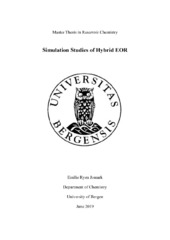| dc.description.abstract | Injection of low salinity brine in combination with surfactant and polymer for enhanced oil recovery (EOR) have been proven to substantially increase oil recovery. Large EOR potential exists on the biggest fields on the Norwegian continental shelf, which may provide economically profitable production [1]. This thesis concerns simulation studies of hybrid EOR in 3-dimensional reservoir models representing a North Sea oil field. The simulations were conducted by the ECLIPSE Blackoil Simulator, where the applied models assumed a shift in relative permeability due to salinity change. A field model provided by the research group formed a basis from which a generic sector model could be produced for the purpose of sensitivity studies. In addition to the field model, the research group provided an established core model history matched to a composite coreflooding experiment. During simulations, the response of the simulator to injection fluids was evaluated. The sensitivity of the sector model to change in key reservoir parameters and flow functions was investigated, where final results were applied in the field model. Both models revealed incremental oil recovery caused by an enhanced microscopic sweep by flooding with low salinity water in combination with surfactants. Low salinity water in combination with polymer flooding both accelerated oil recovery and slightly decreased the residual oil saturation through mobility aid, and stabilized flow after high differential pressure was observed when surfactants were injected. The coreflooding experiment was successfully history matched at lab scale, with quantitatively approximately equal results. Predicting model performance based on laboratory results were up-scaled to sector scale and field scale, where simulation results revealed a heterogeneity dependent oil recovery. ECLIPSE successfully modeled the LSSP processes by interpolating salinity dependent relative permeability and capillary pressure, and interpolating surfactant concentration dependent relative permeability and capillary pressure during surfactant flooding. Polymer-oil relative permeability was treated as water-oil relative permeability. | en_US |
